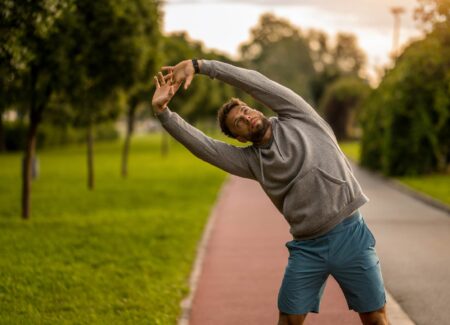

No matter if you’re driving the whole family to the Grand Canyon or flying solo to Bali, the muscle cramps and tightness that can follow a long trip aren’t fun. However, if you’re proactive about stretching and taking care of your body while on vacation, you can minimize the amount of post-trip tension you experience. Take a look at some of the most common types of pain people get while traveling, see how physical therapy can help you address common aches and pains, and highlight some of the best stretches you can do to alleviate it, like:
Anyone who’s been on a long trip can tell you that sitting for too long can cause cramping and stiffness throughout your body. When you’re sedentary for long periods of time, your body produces signals to stop activating the muscles that aren’t moving — resulting in tightness. Factor in poor diet and lack of water consumption, something we’re all guilty of while traveling, and even more intense cramping and aches can happen. While these uncomfortable sensations can happen anywhere in the body, the most common areas where pain occurs while traveling are:
In order to alleviate pain caused by traveling, there are several different stretches you can do to decrease muscle tension, get your blood flowing, and increase mobility.
Before beginning any type of stretching or exercise routine, consult with a qualified healthcare professional like a physical therapist who can educate you on the proper ways to perform these stretches and exercises.
If you’re a fan of the travel-sized neck pillow, the upper trapezius stretch is for you. This stretch helps decrease muscle tension in your neck, and can reduce the likelihood of tension headaches. Since this stretch requires little body movement, you can do this in your seat in the car or standing in line for baggage claim — you name it.
Your neck isn’t the only part of your body that struggles on a long trip. Sitting for too long can lead to stiffness in the lower back, the back of the legs (hamstrings), and even the calf muscles.. The downward dog calf stretch helps get your blood circulating after extended periods of inactivity and can stretch all of these muscles at the same time .
Perfect for a long car or plane ride, the seated twist can be done from a comfortable chair that gives you the mobility to move around a bit. This stretch helps loosen the muscles in your lower back and improve circulation. You might even be able to release some tension with a much-needed back pop. Take a look at how to perform this stretch:
Stiff and achy legs are a common symptom of a long trip, especially if you don’t have the proper amount of legroom. The quadricep stretch helps loosen the muscles just above the knee joint, releasing tension in your quads and increasing blood flow around your knees. All you need for this exercise is a supportive object — a car door, an airport wall, or anything you can find during your travels that will give you some support.
If you usually rely on a yoga class to help stretch out your muscles, the modified prayer stretch might be your go-to move for relieving your post-travel pain. This move, similar to the traditional prayer stretch, helps release tension in your lower back and hamstrings. The modified prayer stretch doesn’t require any equipment. To perform this stretch, all you need is a surface that’s about the height of your hips, like a table or countertop.
While touching your toes is a fairly simple stretch that we all learn at a young age, it’s one of the most effective to relieve muscle tension from traveling and to prevent cramping. Toe touches help stretch your hamstrings and improve circulation in the lower-half of your body.
Physical therapy can help you address those travel injuries or travel aches and pains. Our physical therapists will work with you to develop and implement a personalized treatment plan that aligns with your unique needs and goals. Request an appointment today at a nearby physical therapy clinic to see how physical therapy can help you address travel aches and pains.


